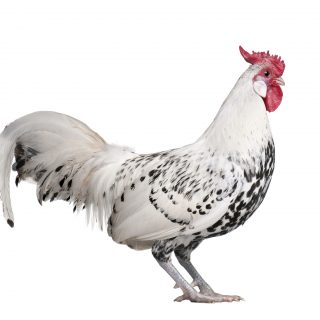Crested chicken breeds tend to be made up of some of the most beautiful-looking birds you can find. Crested means that the birds have plumage on top of their heads, some to the point of looking like they have on hats. There are several crested breeds to choose from, and even some that will do well in confinement or are hardy even when placed in cold weather.
Crested chickens, in general, tend to be a friendly type of chicken that can get along with others. Many chickens with cresting can be placed in shows, and some are rare varieties that many chicken enthusiasts would be incredibly happy to get their hands on. While things do vary from breed to breed. Many of the crested chicken breeds are used for egg production, although you shouldn’t be expecting to bring home a hen that produces 200 eggs and lays year-round.
Some popular crested breeds that you might have heard of include the Silie, a chicken that’s covered head to toe in feathers, and the Legbars. Along with these two, the list below contains nine other crested breeds to choose from. Surprisingly many of the breeds are ancient and have been around for several hundred years. Some have even been treated as royal birds in the past.
The wild feathering of these breeds can also lend to some fun chicken names.
If the look of crested chickens has you interested, then keep reading below to learn which of the breeds you are most interested in.
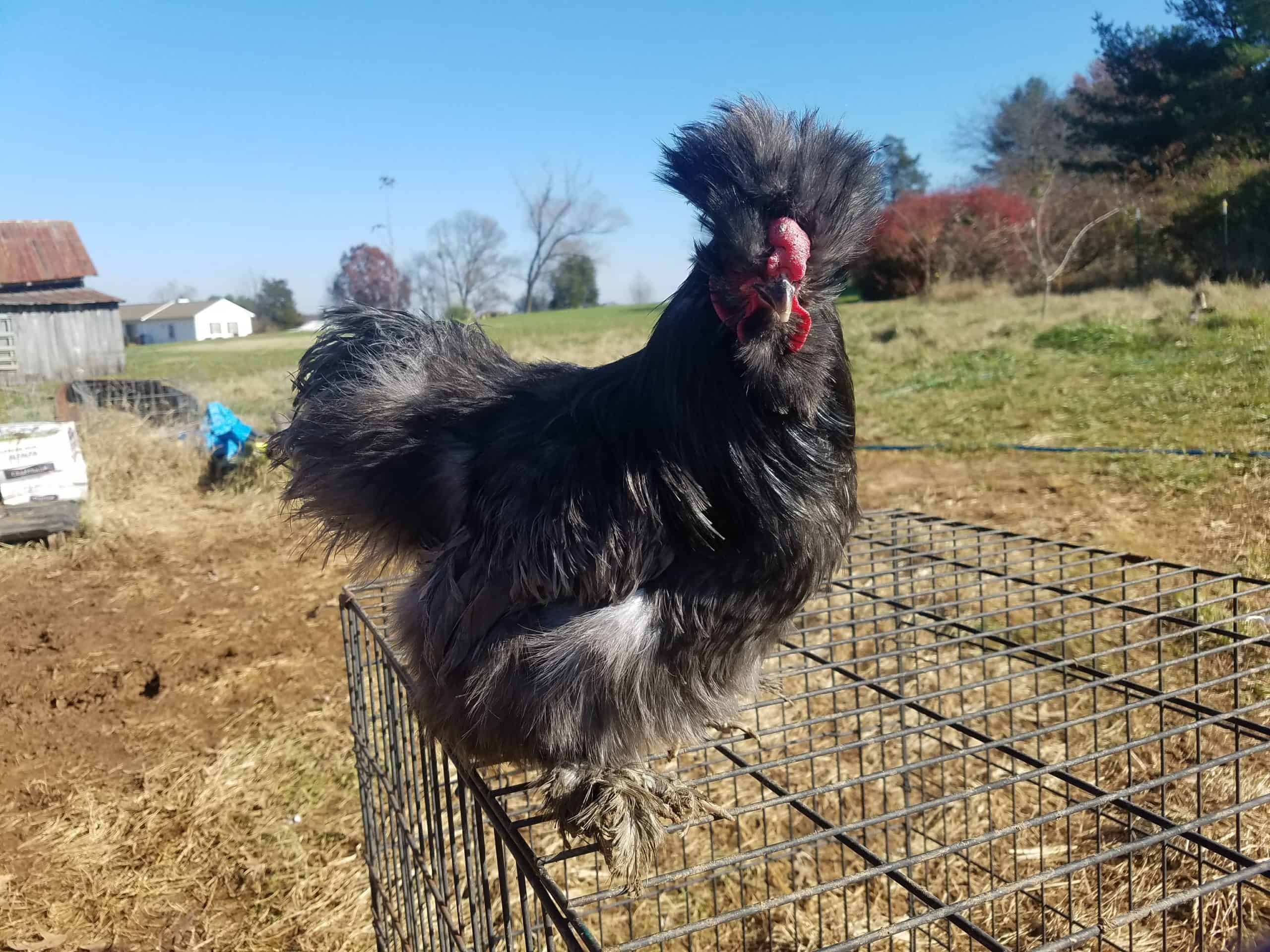
Crested Chicken Breeds
| Breed | Purpose | Eggs/Yr | Egg Color |
|---|---|---|---|
| Silver Spangled Apenzeller | Eggs | 150 eggs per year | White |
| Polish | Show & Eggs | 200 eggs per year | White |
| Sultan | Show | 50 eggs per year | White |
| Houdan | Show & Eggs | 150 eggs per year | White |
| Legbars - Cream and Frost White | Eggs | 180 eggs per year | Blue or Green |
| Brabanter | Eggs | 150 eggs per year | White |
| Polverara | Show & Eggs | 150 eggs per year | White |
| Padovana | Meat & Eggs | 120 eggs per year | Cream & Light-brown |
| Silkie | Show & Eggs | 160 eggs per year | Cream |
| Crevecoeur | Show & Eggs | 120 eggs per year | White |
| Swedish Flower Hen | Meat & Eggs | 150 eggs per year | Brown |
[ez-toc]
Breed 1: Silver Spangled Apenzeller
Silver Spangled Appenzeller chickens are a rare breed that has not yet been recognized by the APA. They aren’t good for meat as they are a small breed with roosters usually weighing 4 and a half pounds, and the hens usually weigh around 3 and a half pounds. Apenzellar chickens tend to lay somewhere around 150 medium-sized white eggs a year. Apenzellars have heavy feathering on their heads, a spangled feather pattern, and a red V-shaped comb.
This is a breed that prefers to free-roam as they don’t like to be confined for long periods of time. They are a hardy breed of chicken that tends to be docile and can easily live with other breeds of chicken. The Apenzellar is also a breed that tends to go broody fairly often.
Breed 2: Polish
The Polish chicken comes from the country of Poland and is an ancient breed that has been around for quite some time. This is a breed that tends to lay somewhere around 200 white medium-sized eggs a year.
Polish chickens are a show birds, so they have strict standards. Polish chickens should have heavy feathering on their head, a v-shaped comb, and in some cases even have a beard. Being ornate, hens and roosters look fairly similar and can be difficult to distinguish, at times. They aren’t one of the largest chicken breeds, but the roosters do grow to be around 6 pounds, while the hens usually reach 4 and a half pounds.
They are a nervous breed of chicken and will need a stable environment to live in. Polish chickens are sensitive to the cold, so you will need to have a well-insulated coop, but otherwise, they are a hardy bird. They do like to free-range, so you will want to let them out regularly. Polish hens don’t tend to go broody often, making breeding a bit more difficult.
Need some help keeping your chickens health and care taken care of? Check out the Organized Chicken Keeper for an easy to follow system.
Breed 3: Sultan
The Sultan chicken is a strikingly beautiful bird who isn’t really suitable for egg production. They come from Turkey, where they used to be kept in the courtyard of palaces. The Sultan only lays around 50 small eggs a year and is a small bird. The rooster will only reach a weight of six pounds, with the hens just weighing in at 4 pounds. This breed really shines as a show bird and has been accepted by the APA since 1874, making them one of the oldest competitive breeds.
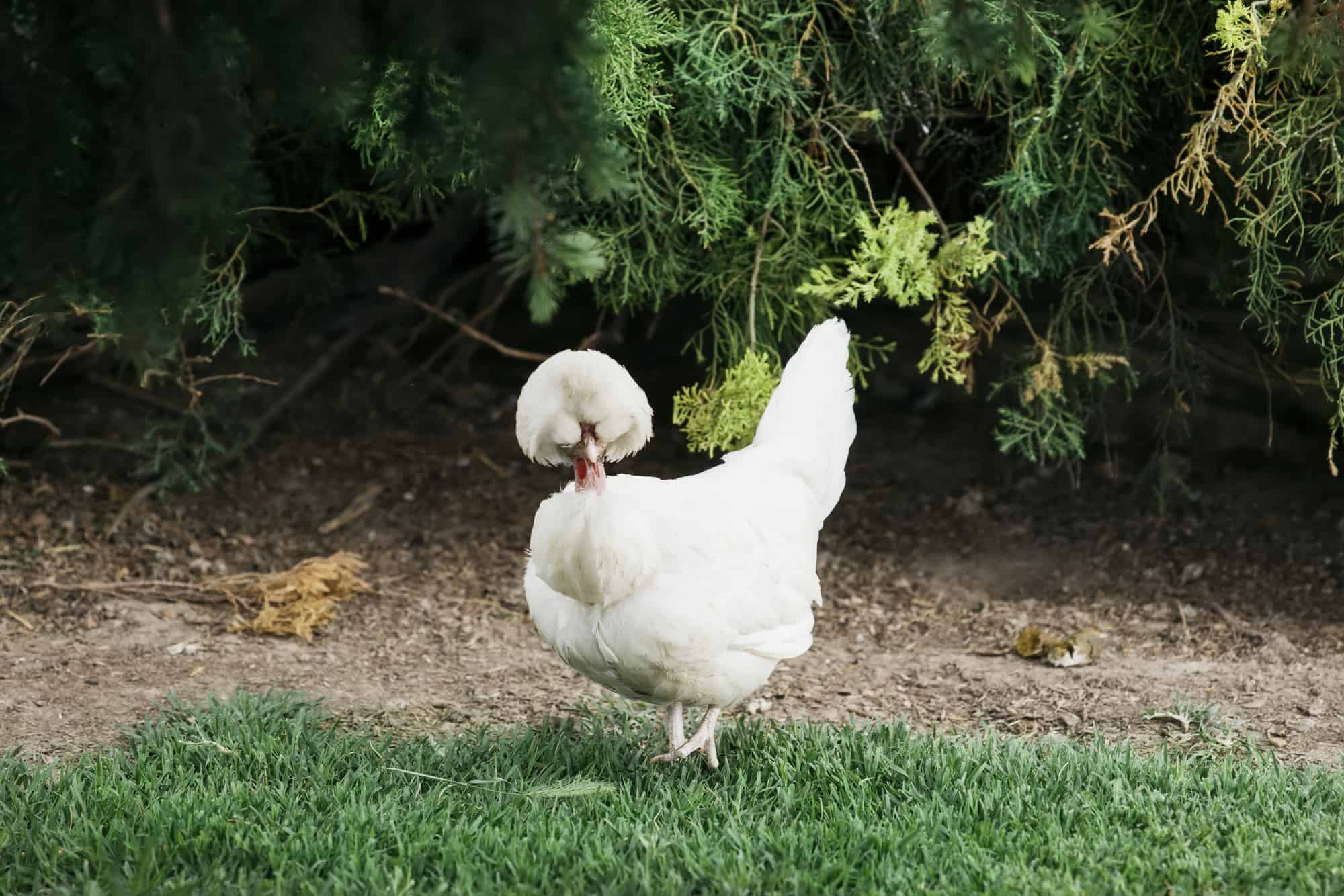
The plumage on the head of the Sultan wraps around their head, and they have feathers covering their legs and feet. This royal bird has a v-shaped comb and a docile personality. Despite all their heavy feathering, though, they aren’t a breed that is able to tolerate the cold well. Sadly, Sultans don’t tend to be a broody breed of chicken, and due to their low egg numbers, they are generally pretty hard to breed.
Breed 4: Houdan
The Houdan Chicken is an old breed of French chickens that's age and origins are hard to trace back. Houdans typically lay around 150 medium-sized white eggs a year. The Houdan is a medium-sized bird with roosters weighing around 8 pounds, while the hens usually weigh in somewhere around 6 and a half pounds. The Houdan a v or butterfly-shaped comb, a flowering cresting, and have been accepted by the APA since 1874.
Houdans are a sweet breed of chicken that gets along with both humans and other breeds. They enjoy being free-range but aren’t going to do well in colder areas of the world. Luckily, Houdan hens do tend to be broody.
Breed 5: Legbars - Cream and Frost White
The Legbar is a chicken breed that comes from the UK. It was created at Cambridge University. This breed is an auto-sexing breed, meaning that you can tell the sex of the chicken at birth. This is a colored egg laying chicken. This breed is a chicken that lays blue eggs or lays green eggs, and a hen can produce 180 medium-sized eggs a year. The rooster weighs around 6 to 7 pounds, while hens typically weigh between 4 and a half to six pounds. Both the gold and silver Legbar chickens possess cresting, and the breed has a single comb.
Legbars are an active breed that doesn’t like to confinement, but they do have a friendly nature. They are a hardy breed that can do well in the cold, making them perfect for those who live in colder regions. Legbars can be broody, but you still may want to have an incubator on hand.
Breed 6: Brabanter
The Brabanter chicken is a rare breed that seems to have come from either the Netherlands or Belgium. The breed generally lays around 150 large white eggs a year but is small in size. Brabanter chickens tend to weigh around 4 to five pounds for the rooster and 3 and a half to 4 and a half pounds for the hen. They have a narrow crest, a three-part beard, and a V-shaped comb.
They are a calm breed that can easily get along with others and tend to be quite curious. Brabanters like to forage, so letting them roam around outside can help trim their nails down, but they don’t mind being put up in a coop either. They are a hardy breed that can do well in extremely cold temperatures. The Brabanter is a broody breed of chicken that loves sitting on their eggs.
Breed 7: Polverara
Polverara is an Italian breed that gets it's name from the area where many believe it comes from.
They will usually lay around 150 white medium-size eggs a year and are also good for meat production. The roosters typically weigh somewhere around 6 pounds, while the hens weigh in at around four pounds. Sadly they are an extremely rare breed, and there aren’t a large amount of them around anymore. They have a small crest that grows upward and a V-shaped comb.
Sadly, this is a breed that hasn’t been able to get on board with being confined, so they will need to be kept outside. With that, they do tend to be a hardy breed. They are friendly and don’t mind people handling them. The Polverara can go broody, but it’s also best to keep an incubator on hand.
Breed 8: Padovana
Padovana chickens is another old Italian breed that get its name from the providence of Padua. The Padovana is an ok layer, and you can expect them to lay around 120 small eggs a year. The roosters weigh around 9 to 10 pounds, while the hens will weigh between 7 and a half to 10 pounds. This makes them a good choice as a meat-producing bird. The Padovana is a combless breed that has an upright crest covering its head.
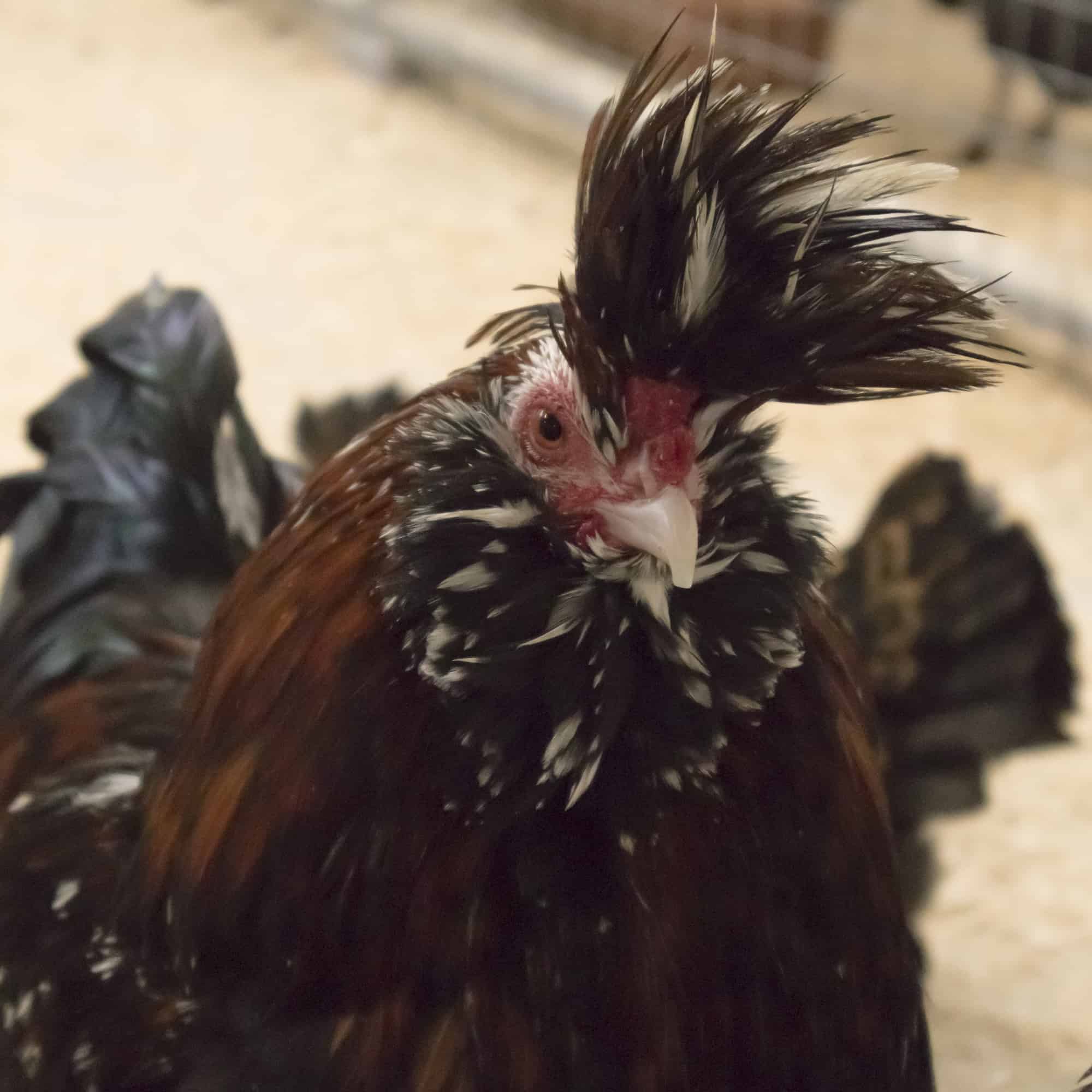
The Padovana is a confident bird that is friendly with humans and other breeds of chickens. These chickens do like to free-range and are a hardy breed. Padovana hens aren’t broody, so you will need to use an incubator to hatch the chicks.
Breed 9: Silkie
Silkies are a popular breed of chickens that have been around since ancient times in China. As their name suggests, they are a bird with soft feathers that have full body coverage, head to feather toes, in a fluffy plumage. They can lay around 170 eggs a year and are right at home at a chicken show. Roosters typically only weigh between 2 to 3 pounds, while hens weigh even less at 1 and a half to 2 pounds. The bird has a walnut comb that has a high chance of being covered up by its feathers.
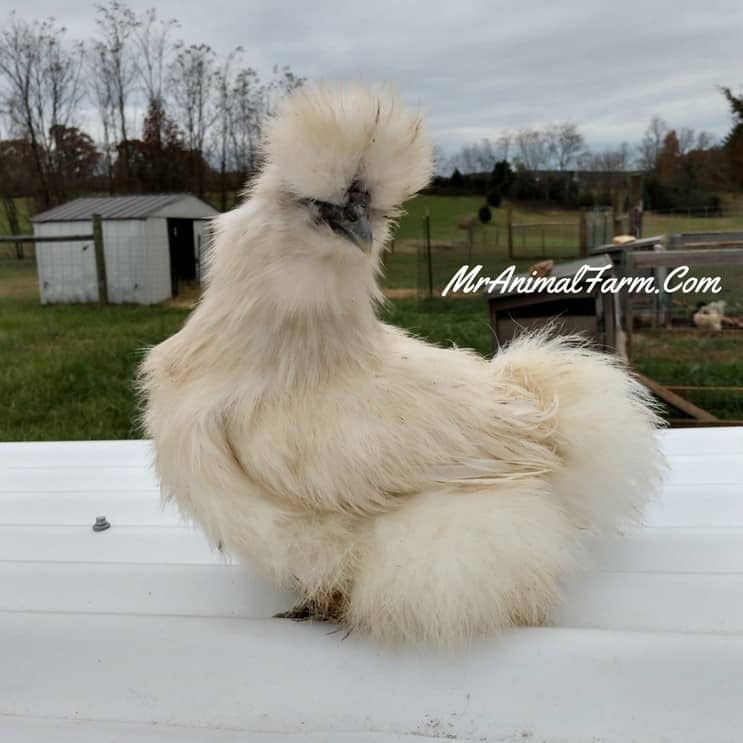
The silkie is a calm, friendly bird that can get along with others. They are also a cold hardy breed despite how delicate they look and can live in several different types of weather. They can be free-range, but for this breed, a chicken run is highly advised. Silkie hens are very broody and will focus on taking care of their eggs.
Breed 10: Crevecoeur
Crevecoeur is an extremely rare French breed of chicken that is currently considered to be endangered. The breed only lays around 120 medium-sized white eggs a year and isn’t used for meat. It looks similar to the Houdan with its crest and also has a V-shaped comb. The rooster generally weighs around 8 pounds, while a hen will weigh around 4 and a half pounds.
They have an active temperament and can get along well with others. Crevecoeurs are happiest when they are able to run around outside, so allowing them to free-range is best. They aren’t a cold hardy breed and may not fare well in some regions. Crevecoeur chickens seem to go both ways with broodiness, so you will want to keep an eye on your hens and an incubator on the side.
Breed 11: Swedish Flower Hen (sometimes)
The Swedish Flower chick isn’t always a crested breed, but some do develop smaller crests on top of their heads. This breed tends to lay around 150 large or jumbo brown eggs a year. The roosters typically weigh in at around 8 pounds, while the hens weigh around 5 pounds; making them great dual purpose chickens for both eggs and meat. They have spots that look somewhat like flowers on their feathers and have a single serrated comb.
Swedish Flower Hens tend to be a calm breed that gets along well with others. They do well with being free-range and are a hardy breed that can even do well in colder regions where some other breeds might not thrive. The Swedish Flower hen doesn’t tend to be a broody breed, so you will need to use an incubator to hatch the chicks.
What do crested chickens look like?
Crested breeds, like any other chicken breed, can vary in appearance. Some are small while others are large, and they have several different comb types. One thing that they all do have in common is the feathers that grow atop their heads. Crested breeds will often have their heads completely covered in feathers, some to the point that their combs are completely hidden.
Some of the crested breeds above are accepted by the APA, meaning that they have breed standards.
You will want to refer to these before you set out to buy chicks. In addition, there are some extremely rare crested breeds like the Brabanter. These chickens will be much harder to find than normal, and you will likely have to spend time looking for a specialty breeder to buy them.
Any Special Care for them?
There are a few things to keep in mind when caring for crested breeds. The biggest problem with them is that the crests can block their eyesight. This makes them much more prone to fall victim to a predator as they can’t keep a close watch on their surroundings. If they are a free-range breed, you will want to either trim their feathers or keep them in a run. Make a note if the breed you are building the run for is good at flying or not; if they are, you will need either high fencing or a net to help keep them from escaping into your yard.
Trimming their feathers can be a problem if they are a show bird, though, so be aware of this when cutting their feathers. In addition, some of the heavily feathered breeds like the Silkie run more of a risk of getting dirty. These breeds may need a bath, especially if you let them free-roam in a muddy area. The mud can cling to their feathers, making them heavy and stressing out your birds.
Lastly, it can be much easier to startle a crested breed. Since they can’t see well in some cases, when you sneak up on them, it can give them a fright. If you intend to touch or pick up your crested chicken, try to let them know that you are there before doing this. By giving them a chance to know that they aren’t in danger, you can alleviate some stress when interacting with them.
Lastly, while many of these breeds are covered in heavy plumage that covers their cold, many of them aren’t cold hardy. Some of the chickens on this list won’t do well when kept in cold regions and many of them like to free-range so around-the-clock confinement isn’t a good option. Be sure to check on how hardy each breed is and how they do in different weather conditions. This can help you determine which crested breeds will do well where you live.
FAQ
Are crested chickens friendly?
For the most part, crested breeds do tend to be friendly. Keep in mind that this can vary from chicken to chicken. The best way to ensure your chicken is friendly is by raising them as chicks and handling them daily.
Are crested chickens good layers?
Typically, crested chickens do seem to lay a decent amount of eggs, with a few exceptions like the Sultan. For the most part, there are no super layers, and many of the chickens will lay around 150 eggs on average.
If you need more help with taking care of your chickens, check out The Organized Chicken Keeper for a complete system for managing their health through keeping their supplies stocked and coop clean.

